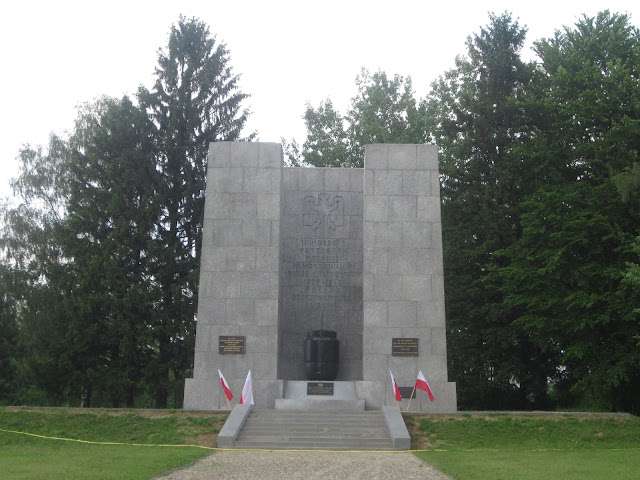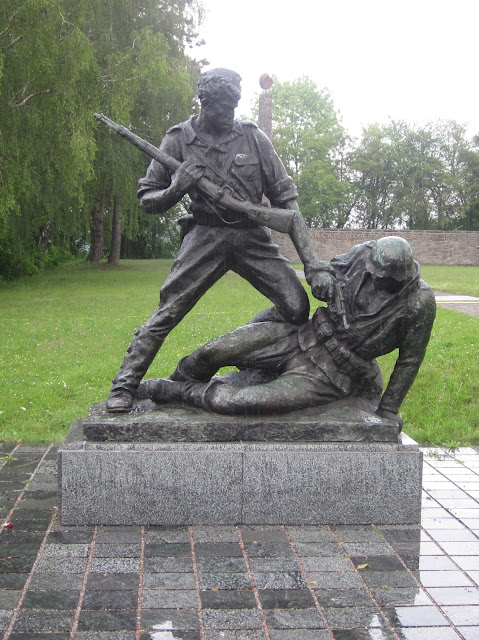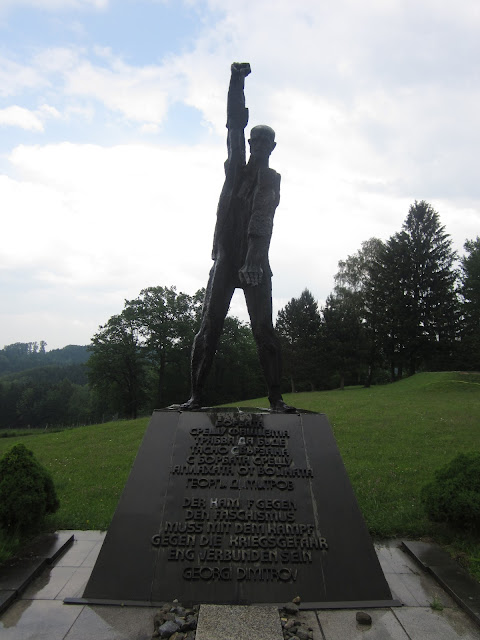As I was researching the origins of a couple of monuments for this blog, I found the story of a statue I included in my last post, the giant block of stone with a man seeming to emerge from its surface. It is called the Karbyshev Monument. Russian General Karbyshev, a leader in the camp's resistance movement, and about 200 other prisoners (some sources say as many as 500) were tortured on February 16, 1945. They were forced to stand outside at night in the freezing winter weather while icy water was poured over them. None of them survived. Rather from escaping the stone, this statue shows a man being gradually encased in a block of "ice."
This statue is located within the walls of the camp, perhaps on the site where the torture occurred. Pretty creepy.
On to the Mauthausen Memorial Sculpture Garden (my name--not official). Mauthausen was declared a national memorial in 1949, and in 1975 it was finally opened as a museum. Between the camp itself and the quarry cliffs is a long, broad, gentle slope:

Dotting this area are memorials that have been built by the countries who lost citizens in the quarries, gas chambers, and other areas of Mauthausen. After the horrible scenes within the camp, this part of our experience--a tribute to pain, suffering, and triumph--was particularly moving. I did not get pictures of all the memorials, but here are most of them:
 |
THE SOVIET UNION, the country that lost the most citizens in the camp, probably over 32,000 soldiers, officers, and civilians
|
|
 |
POLAND, who lost the second most number of citizens, about 30,000 people. The black barrel in the middle reminds me of an urn, a fitting remembrance of the thousands cremated here.
|
 |
CZECHOSLOVAKIA
|
 |
| Close-up shot of the emaciated figure |
 |
| ISRAEL's memorial is shaped like a menorah |
 |
| GREECE |
 |
GREAT BRITAIN's obelisk reads: "In lasting memory of the indomitable British inmates of this camp who, after enduring indescribable suffering and torture, died or were murdered."
|
 |
| SLOVENIA |
 |
| BELGIUM |
 |
| UKRAINE |
 |
| Memorial Wall filled with pictures and lists of names |
 |
| ITALY |
 |
| LUXEMBOURG (shaped like the country) |
 |
ALBANIA (a resistance fighter taking down a Nazi soldier)
|
 |
FRANCE had the first memorial, unveiled in 1949
|
 |
| HUNGARY, resistance fighters raise their fists in triumph |
 |
BULGARIA, another triumphant fist pumper
|
 |
| GERMANY's memorial is very simple |
 |
| The ball and rods make a tiny skeletal figure that is dwarfed by the structure |
 |
YUGOSLAVIA, complete with crematorium smokestacks
|
 |
| Close-up of the tumbling skeletons |
 |
| NETHERLANDS One source says that every single Dutch citizen sent to Mauthausen died, somewhere between 1,000 and 2,000 people |
 |
Plaques like this one inside the Netherlands
Memorial list the names of the dead |
This oversized barbed-wire fence separated the camp from the cliffs. A statue of a woman is seated to the right, with words in German on the wall behind her:
 |
| GERMAN DEMOCRATIC REPUBLIC (EAST GERMANY) |
 |
| A visual oxymoron |
The words were written in 1933 by Bertholt Brecht, German poet, playwright, and theater director. The English translation is:
"O Germany, pale Mother,
How your sons have hurt you
So you are sitting among the nations,
A thing of scorn and fear."
Looking over the iron fence, we could see the quarry and the "stairs of death" below:
A little further out, we could see the pastoral Austrian countryside. That such evil can exist in a place as beautiful as this:
. . . should be a should be a reminder of these words by the Irish statesman Edmund Burke:
"All that is necessary for evil to triumph is for good men to do nothing."

































Nice. I get teary just re-looking at the memorials. So many beautiful and moving sculptures. A sad statement about how bad man can be and our inability to confront difficult problems. I am glad that we did not have to live through those horrors.
ReplyDeleteI will never forget this place. It was incredibly moving.
ReplyDeleteWhat to say in the face of this horrific suffering, as suggested by all the memorials? Glad to see so many countries placed something to remember their dead citizens here.
ReplyDelete